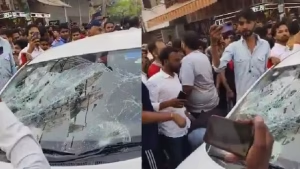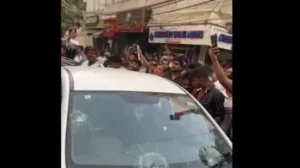New Delhi – In a disturbing incident that has sent shockwaves through the capital’s coaching hub, six pedestrians were severely injured when an intoxicated driver crashed into them in Old Rajinder Nagar on Tuesday evening. The Delhi Old Rajinder Nagar accident, which occurred around 6 PM, primarily affected UPSC aspirants who were returning from coaching centers in the area.
According to police officials investigating the Delhi Old Rajinder Nagar accident, the driver, identified as Prem Kumar, was immediately apprehended at the scene. A breathalyzer test administered on-site confirmed Kumar was under the influence of alcohol when the accident occurred. Deputy Commissioner of Police M Harsha Vardhan told reporters that Kumar’s blood samples have been collected to determine precise alcohol levels, which will strengthen the case against him.
“The Delhi Old Rajinder Nagar accident is being treated with utmost seriousness,” DCP Vardhan said. “Kumar was operating his employer’s vehicle at the time of the collision. We are investigating whether there were previous instances of similar behavior and if his employer was aware of any alcohol issues.”
Five of the injured individuals were identified as UPSC aspirants who had relocated to Delhi to pursue their civil service examination preparations. The sixth victim was reportedly visiting the area when caught in the Delhi Old Rajinder Nagar accident. All victims—identified as Lokesh, Baby, Shivam, Harshita, Stephen, and Vipul—were rushed to nearby medical facilities immediately following the incident.
Victims’ Status Following the Delhi Old Rajinder Nagar Accident
Medical personnel treating the victims of the Delhi Old Rajinder Nagar accident have reported that while five of the injured are expected to be discharged soon, one victim may require extended hospitalization and treatment. Authorities have confirmed that despite the severity of the collision, all six individuals are currently in stable condition.
Dr. Priya Sharma, who is overseeing the treatment of those injured in the Delhi Old Rajinder Nagar accident, explained, “The victims sustained various degrees of injuries ranging from contusions and lacerations to potential fractures. We’ve conducted comprehensive examinations, including CT scans and X-rays, to rule out any internal injuries that might not be immediately apparent.”
The parents of several victims have already arrived in Delhi from various parts of the country after receiving news of the Delhi Old Rajinder Nagar accident. Rakesh Mehta, father of one injured student, expressed his anguish: “My son came to Delhi with dreams of becoming an IAS officer. Now I’m visiting him in a hospital bed because someone decided to drive while intoxicated. This Delhi Old Rajinder Nagar accident has shattered our peace of mind.”
Growing Concern in the Aftermath of the Delhi Old Rajinder Nagar Accident
The Delhi Old Rajinder Nagar accident has sparked renewed concerns about pedestrian safety in areas with high concentrations of students and coaching centers. Old Rajinder Nagar, known as a hub for UPSC aspirants with dozens of coaching institutes operating in the vicinity, sees substantial foot traffic throughout the day.

Local residents had previously raised concerns about traffic management and pedestrian safety in the area. Rakesh Gupta, president of the Old Rajinder Nagar Residents’ Welfare Association, stated that the Delhi Old Rajinder Nagar accident was “unfortunate but not entirely unexpected.”
“We’ve been warning authorities about the dangers pedestrians face in this area for years,” Gupta said. “The Delhi Old Rajinder Nagar accident is a tragic manifestation of systemic neglect. With thousands of students moving through these narrow streets daily, coupled with impatient drivers and inadequate infrastructure, we’ve been sitting on a powder keg.”
Following the Delhi Old Rajinder Nagar accident, several coaching institutes have joined hands to demand improved safety measures. Rohit Jain, director of a prominent UPSC coaching center near the accident site, emphasized, “Our students come from across India to pursue their dreams. The least we can ensure is their physical safety. This Delhi Old Rajinder Nagar accident highlights urgent infrastructure concerns that must be addressed.”
Legal Proceedings After the Delhi Old Rajinder Nagar Accident
Police officials have confirmed that stringent legal action is being initiated against Prem Kumar following the Delhi Old Rajinder Nagar accident. Kumar, who works as a professional driver, now faces multiple charges including dangerous driving, driving under the influence, and causing grievous harm through negligent driving.

“The accused in the Delhi Old Rajinder Nagar accident will face the full force of the law,” affirmed Additional Deputy Commissioner Rajiv Sharma. “We are gathering eyewitness testimonies and surveillance footage from nearby establishments to reconstruct the exact sequence of events leading to the collision.”
Legal experts familiar with similar cases suggest that Kumar could face imprisonment between two to five years if convicted for the Delhi Old Rajinder Nagar accident. Additionally, his driving license is likely to be suspended or permanently revoked depending on the severity determined by the court.
Kumar’s employer, whose vehicle was involved in the Delhi Old Rajinder Nagar accident, may also face accessory charges if investigations reveal any negligence in vehicle maintenance or awareness of Kumar’s drinking habits. Authorities are currently determining whether the employer had implemented any protocols to ensure drivers remained sober while operating their vehicles.
Eyewitness Accounts of the Delhi Old Rajinder Nagar Accident
Several bystanders who witnessed the Delhi Old Rajinder Nagar accident described scenes of chaos and quick community response following the collision. Manish Kumar, who runs a stationery shop near the accident site, recounted the moments immediately after the incident.
“I heard a loud crash followed by screams, and when I rushed outside, I saw several students lying on the road,” Manish said regarding the Delhi Old Rajinder Nagar accident. “The driver seemed disoriented but was unable to flee as locals immediately surrounded the vehicle. Many people quickly mobilized to help the injured before ambulances arrived.”
Another witness to the Delhi Old Rajinder Nagar accident, Preeti Sharma, a UPSC aspirant herself, described how the driver appeared to lose control of the vehicle before mounting the sidewalk where students were walking. “The car was moving erratically even before the collision. Several pedestrians had to jump out of the way, but unfortunately, not everyone could react in time,” she recalled of the Delhi Old Rajinder Nagar accident.
The quick response of local residents after the Delhi Old Rajinder Nagar accident has been praised by medical personnel who arrived at the scene. Dr. Arvind Mehra of the ambulance service that transported the victims stated, “The immediate first aid provided by bystanders after the Delhi Old Rajinder Nagar accident potentially prevented more serious outcomes. The community’s quick thinking in stabilizing the injured and alerting emergency services exemplifies the best of civilian response.”
Analysis of Rising Accidents in Delhi’s Educational Hubs
The Delhi Old Rajinder Nagar accident is not an isolated incident but part of a concerning pattern of traffic-related injuries in areas with high student populations. Traffic safety experts have noted that the combination of narrow lanes, limited parking, high pedestrian density, and inadequate traffic management creates perfect conditions for such incidents.
Dr. Sanjeev Sharma, a road safety analyst who has studied accidents similar to the Delhi Old Rajinder Nagar accident, explained, “Educational hubs in Delhi have evolved organically without proper urban planning. When thousands of students congregate in areas not designed for such foot traffic, while simultaneously dealing with impatient Delhi traffic, the risk factors multiply exponentially.”
Statistics from the Delhi Traffic Police reveal that areas with coaching centers have seen a 15% increase in pedestrian-related accidents over the past three years. Prior to the Delhi Old Rajinder Nagar accident, three similar incidents had been reported in coaching hubs across Delhi in 2024 alone, injuring a total of eleven people.
A large crowd of locals and students gathered on the spot, demanding justice for the injured. A UPSC aspirant called for strict action against the car driver and he said; “It is not an unusual thing anymore to see such incidents. Moreover, due to the ongoing construction, there is little space to walk and the area has no speed breakers in Bada Bazar. It was just bound to happen because of the negligence of the authorities,” the student said.
Bala Krishna , a UPSC aspirant living in the Old Rajinder Nagar area for the past five years, alleged that the authorities have always neglected students’ demands.
“Be it last year when students died due to flooding in the basement of a coaching centre or today when five UPSC aspirants have been injured, nothing has changed,” he said.
“The Delhi Old Rajinder Nagar accident should serve as a catalyst for comprehensive safety reforms,” urged traffic consultant Priya Mathur. “We need dedicated pedestrian zones, proper sidewalks, speed-limiting measures, and strategic deployment of traffic personnel during peak hours to prevent future tragedies similar to the Delhi Old Rajinder Nagar accident.”
Government Response to the Delhi Old Rajinder Nagar Accident
Following the Delhi Old Rajinder Nagar accident, city officials have announced immediate measures to enhance pedestrian safety in the area. Delhi’s Transport Minister Rajesh Kumar visited the accident site on Wednesday morning and promised swift action.
“The Delhi Old Rajinder Nagar accident is deeply troubling, and we are committed to preventing such incidents in the future,” Minister Kumar stated. “I have directed the transport department to conduct a comprehensive safety audit of all major coaching hubs in Delhi, beginning with Old Rajinder Nagar. We will implement necessary infrastructure changes based on expert recommendations.”
In response to the Delhi Old Rajinder Nagar accident, the Delhi Traffic Police announced increased patrols and more stringent enforcement of traffic regulations in educational zones. “We’re implementing a zero-tolerance policy for traffic violations in areas with high student populations,” stated Joint Commissioner of Traffic, Sanjay Bhatia. “The Delhi Old Rajinder Nagar accident has highlighted the urgent need for stricter enforcement and preventive measures.”
The Municipal Corporation of Delhi has also responded to the Delhi Old Rajinder Nagar accident by announcing plans to improve street lighting, expand sidewalks, and install protective barriers in high-risk stretches identified through traffic pattern analysis.
Impact on UPSC Community After the Delhi Old Rajinder Nagar Accident
The Delhi Old Rajinder Nagar accident has sent ripples of concern through Delhi’s vast UPSC aspirant community, estimated at over 300,000 students. Many of these aspirants relocate to Delhi from across India, often staying in the city for several years while preparing for the rigorous civil services examinations.
Following the Delhi Old Rajinder Nagar accident, several coaching institutes have announced transportation services for students attending evening classes. “Student safety is paramount, and the Delhi Old Rajinder Nagar accident has prompted us to arrange shuttle services for students attending late classes,” announced Deepak Sharma, director of Paramount Coaching Institute.
Student associations have mobilized after the Delhi Old Rajinder Nagar accident, organizing awareness campaigns about road safety and petitioning local authorities for dedicated pedestrian zones. Amit Chaudhary, president of the UPSC Aspirants Association, emphasized, “The Delhi Old Rajinder Nagar accident has highlighted vulnerabilities that thousands of students face daily. We are drafting comprehensive recommendations for authorities to make coaching hubs safer for pedestrians.”
Social media platforms have seen an outpouring of support for victims of the Delhi Old Rajinder Nagar accident, with many current and former civil servants offering assistance. Several IAS officers have volunteered to help with medical expenses and rehabilitation costs for those injured in the Delhi Old Rajinder Nagar accident.
Broader Implications of the Delhi Old Rajinder Nagar Accident


The Delhi Old Rajinder Nagar accident has reignited the national conversation about India’s road safety crisis. With over 150,000 annual road fatalities nationwide, India accounts for approximately 11% of global road accident deaths despite having only 1% of the world’s vehicles.
Road safety advocates are pointing to the Delhi Old Rajinder Nagar accident as evidence of the need for stronger penalties for drunk driving. Anjali Sharma of the Road Safety Network India commented, “The Delhi Old Rajinder Nagar accident demonstrates why we need automatic license revocation and mandatory jail time for first-time drunk driving offenders. Current penalties clearly aren’t deterring this dangerous behavior.”
Urban planners are also citing the Delhi Old Rajinder Nagar accident as an example of how educational zones require specialized urban design considerations. “Areas with high concentrations of educational institutions need different traffic management and pedestrian infrastructure than regular residential or commercial zones,” explained urban design specialist Vikram Singh. “The Delhi Old Rajinder Nagar accident shows the consequences of ignoring these specialized needs.”
Preventive Measures Following the Delhi Old Rajinder Nagar Accident
In the immediate aftermath of the Delhi Old Rajinder Nagar accident, several proactive measures have been implemented or proposed:
-
In the wake of the Delhi Old Rajinder Nagar accident, authorities have implemented several new safety measures aimed at preventing such tragedies in the future. These steps are part of a broader push to improve road safety, particularly in densely populated educational zones frequented by thousands of students each day.
The Delhi Traffic Police have established checkpoints near coaching hubs for breathalyzer testing, directly responding to the reckless driving behavior suspected to have caused the accident. These checkpoints are operational during peak hours, with a focus on screening commercial vehicle drivers for alcohol consumption and enforcing stricter penalties for violations.
Simultaneously, local authorities have initiated an emergency review of pedestrian infrastructure in Old Rajinder Nagar and other coaching-dense neighborhoods. This includes assessing the need for more footbridges, better signage, functional traffic lights, and designated crossing zones to safeguard students and residents.
The transport department has also proposed mandatory GPS tracking for all commercial vehicles operating in and around coaching areas. This initiative will enable real-time monitoring of driver speed and route compliance, helping identify patterns of reckless driving before they result in harm.
Resident welfare associations have stepped in by organizing civilian traffic volunteers to assist with pedestrian crossings and vehicle flow management at key intersections during busy hours. Their involvement aims to supplement official traffic enforcement with community-driven safety.
Additionally, several major coaching institutes have adjusted class timings to stagger student movements, especially during the high-risk evening window when the Delhi Old Rajinder Nagar accident took place. This helps ease congestion and ensures safer transit for students.
Closing Remarks: Lessons from the Delhi Old Rajinder Nagar Accident
The accident serves as a sobering reminder of the fragility of pedestrian safety in India’s densely populated urban centers. As investigations continue and the injured recover, the incident has catalyzed important conversations about urban planning, traffic management, law enforcement, and community responsibility.
For the thousands of students pursuing their dreams in Delhi’s coaching hubs, the accident represents both a tragedy and a call to action. Their safety depends on a coordinated approach involving multiple stakeholders—from government authorities and educational institutions to local businesses and residents.
As Deputy Commissioner Vardhan noted in his final statement about the accident, “Every pedestrian deserves to walk our streets without fear. This incident reminds us that road safety is not just about infrastructure or enforcement but about fostering a culture of responsibility and care for fellow citizens.”
The accident, while traumatic for all involved, may ultimately lead to safer conditions for the thousands of aspirants who come to Delhi chasing their dreams of public service—provided that lessons are learned and meaningful changes implemented.

